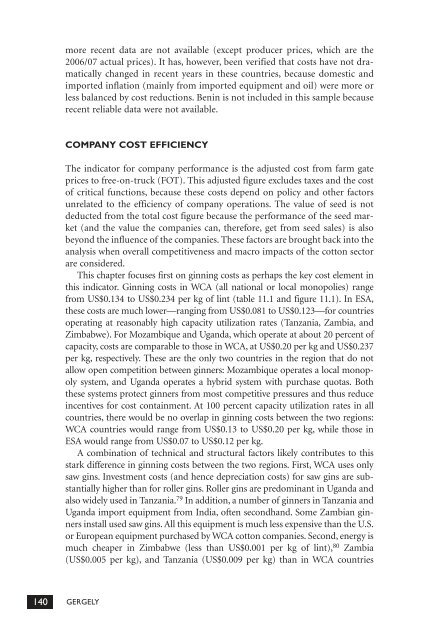Organization and Performance of Cotton Sectors in Africa ... - infoDev
Organization and Performance of Cotton Sectors in Africa ... - infoDev
Organization and Performance of Cotton Sectors in Africa ... - infoDev
You also want an ePaper? Increase the reach of your titles
YUMPU automatically turns print PDFs into web optimized ePapers that Google loves.
more recent data are not available (except producer prices, which are the2006/07 actual prices). It has, however, been verified that costs have not dramaticallychanged <strong>in</strong> recent years <strong>in</strong> these countries, because domestic <strong>and</strong>imported <strong>in</strong>flation (ma<strong>in</strong>ly from imported equipment <strong>and</strong> oil) were more orless balanced by cost reductions. Ben<strong>in</strong> is not <strong>in</strong>cluded <strong>in</strong> this sample becauserecent reliable data were not available.COMPANY COST EFFICIENCYThe <strong>in</strong>dicator for company performance is the adjusted cost from farm gateprices to free-on-truck (FOT). This adjusted figure excludes taxes <strong>and</strong> the cost<strong>of</strong> critical functions, because these costs depend on policy <strong>and</strong> other factorsunrelated to the efficiency <strong>of</strong> company operations. The value <strong>of</strong> seed is notdeducted from the total cost figure because the performance <strong>of</strong> the seed market(<strong>and</strong> the value the companies can, therefore, get from seed sales) is alsobeyond the <strong>in</strong>fluence <strong>of</strong> the companies. These factors are brought back <strong>in</strong>to theanalysis when overall competitiveness <strong>and</strong> macro impacts <strong>of</strong> the cotton sectorare considered.This chapter focuses first on g<strong>in</strong>n<strong>in</strong>g costs as perhaps the key cost element <strong>in</strong>this <strong>in</strong>dicator. G<strong>in</strong>n<strong>in</strong>g costs <strong>in</strong> WCA (all national or local monopolies) rangefrom US$0.134 to US$0.234 per kg <strong>of</strong> l<strong>in</strong>t (table 11.1 <strong>and</strong> figure 11.1). In ESA,these costs are much lower—rang<strong>in</strong>g from US$0.081 to US$0.123—for countriesoperat<strong>in</strong>g at reasonably high capacity utilization rates (Tanzania, Zambia, <strong>and</strong>Zimbabwe). For Mozambique <strong>and</strong> Ug<strong>and</strong>a, which operate at about 20 percent <strong>of</strong>capacity, costs are comparable to those <strong>in</strong> WCA, at US$0.20 per kg <strong>and</strong> US$0.237per kg, respectively. These are the only two countries <strong>in</strong> the region that do notallow open competition between g<strong>in</strong>ners: Mozambique operates a local monopolysystem, <strong>and</strong> Ug<strong>and</strong>a operates a hybrid system with purchase quotas. Boththese systems protect g<strong>in</strong>ners from most competitive pressures <strong>and</strong> thus reduce<strong>in</strong>centives for cost conta<strong>in</strong>ment. At 100 percent capacity utilization rates <strong>in</strong> allcountries, there would be no overlap <strong>in</strong> g<strong>in</strong>n<strong>in</strong>g costs between the two regions:WCA countries would range from US$0.13 to US$0.20 per kg, while those <strong>in</strong>ESA would range from US$0.07 to US$0.12 per kg.A comb<strong>in</strong>ation <strong>of</strong> technical <strong>and</strong> structural factors likely contributes to thisstark difference <strong>in</strong> g<strong>in</strong>n<strong>in</strong>g costs between the two regions. First, WCA uses onlysaw g<strong>in</strong>s. Investment costs (<strong>and</strong> hence depreciation costs) for saw g<strong>in</strong>s are substantiallyhigher than for roller g<strong>in</strong>s. Roller g<strong>in</strong>s are predom<strong>in</strong>ant <strong>in</strong> Ug<strong>and</strong>a <strong>and</strong>also widely used <strong>in</strong> Tanzania. 79 In addition, a number <strong>of</strong> g<strong>in</strong>ners <strong>in</strong> Tanzania <strong>and</strong>Ug<strong>and</strong>a import equipment from India, <strong>of</strong>ten secondh<strong>and</strong>. Some Zambian g<strong>in</strong>ners<strong>in</strong>stall used saw g<strong>in</strong>s. All this equipment is much less expensive than the U.S.or European equipment purchased by WCA cotton companies. Second, energy ismuch cheaper <strong>in</strong> Zimbabwe (less than US$0.001 per kg <strong>of</strong> l<strong>in</strong>t), 80 Zambia(US$0.005 per kg), <strong>and</strong> Tanzania (US$0.009 per kg) than <strong>in</strong> WCA countries140 GERGELY
















